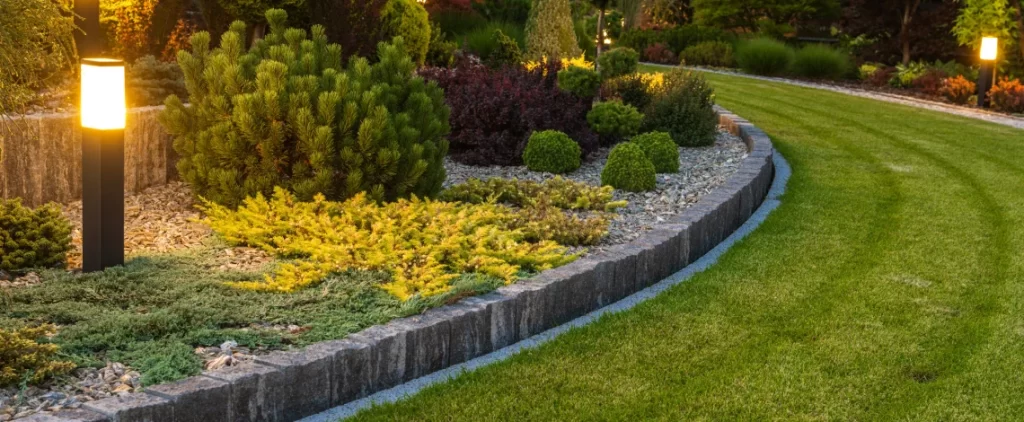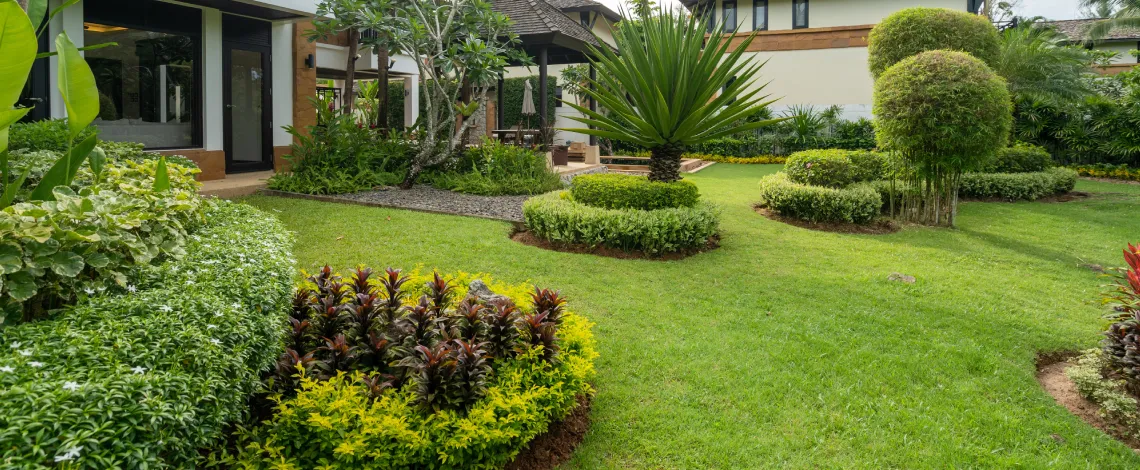Ever felt like your commercial property’s landscape is working against you? One week, the irrigation fails, the next week weeds take over, and flower beds always need attention. Between emergency repairs and constant upkeep, landscape maintenance can quickly become the most stressful part of property management.
Managing commercial landscapes shouldn’t feel like a constant battle. The secret lies in effective landscape design that works with nature instead of against it. These low-maintenance landscape design approaches often create more attractive and professional-looking properties than traditional high-maintenance designs.
The Business Case for Easy-Care Landscapes
Traditional commercial landscaping feels like a money pit. Water bills climb higher each month. Maintenance crews work overtime, keeping everything trimmed and tidy. Plant replacements become a regular expense. Worst of all, these costs seem to multiply during the hottest months when your landscape needs the most attention.
Smart landscape design flips this script completely. The right plants flourish in your local climate without constant intervention. Well-chosen hardscape features stay attractive for decades. Water-efficient systems cut utility costs while keeping plants healthy. Your property maintains its professional appearance while your maintenance headaches disappear.
Plant Selection: The Foundation of Low-Maintenance Success
Making smart plant choices from the start determines whether your landscape becomes a maintenance nightmare or a self-sustaining success story. The wrong plants will demand constant attention, frequent replacement, and endless inputs of water and fertilizer. The right plants practically take care of themselves while looking better each year.
Native Species: Nature’s Perfect Solution
Local plants have spent centuries adapting to your specific climate conditions. They handle heat waves, survive dry spells, and resist common pests naturally. These plants essentially maintain themselves once properly established. Florida property managers should consider these winners:
- Coontie: This striking palm relative requires virtually no irrigation after its first year. It maintains perfect form without any pruning while adding tropical character.
- Firebush: Brilliant orange blooms appear year-round, attracting butterflies while thriving in intense heat and humidity. No fertilizer needed.
- Simpson’s Stopper: Small white flowers give way to colorful berries that birds adore. This compact tree tolerates poor soil and drought conditions.
- Coral Honeysuckle: Red trumpet flowers create stunning displays on fences or trellises. This native vine needs no care once established.
Evergreen Plants: Consistent Beauty Without Seasonal Work
Evergreen selections eliminate the seasonal cleanup that deciduous plants require. They provide structure and color throughout the year without dropping leaves or requiring replanting. This consistency reduces labor costs significantly since maintenance crews don’t need to spend time raking, bagging, and disposing of fallen leaves during autumn months. Evergreens also maintain your property’s professional appearance during winter when deciduous plants look bare and uninviting to customers and tenants.
- Dwarf Yaupon Holly stays naturally compact, eliminating frequent trimming needs. Small berries provide wildlife food while adding visual interest.
- Coontie Palms deliver instant tropical appeal while surviving on rainfall alone. Their slow growth means they’ll never outgrow their intended space.
- Marlberry produces glossy foliage and delicate flowers while adapting to various soil conditions. Perfect for foundation plantings or screening.
Perennial Power: Long-Term Value
Perennials represent smart financial choices for commercial properties. Though initial costs may be higher, they return reliably each season without replanting expenses. Even better, most perennials actually expand and improve over time, giving you more coverage and fuller displays without additional investment.
- Blanket Flower displays vibrant yellow and red blooms from early spring through late fall. It self-seeds to fill empty spaces naturally.
- Black-Eyed Susan creates cheerful yellow displays that last for months. This hardy perennial spreads gradually to create fuller plantings over time.
- Purple Coneflower draws butterflies and songbirds while requiring zero maintenance. It even thrives in compacted clay soils.
Remember, the goal is building a plant palette that works harder so you don’t have to. Focus on species that have proven themselves in your climate, and your landscape will reward you with years of low-maintenance beauty.
Cost-Cutting Strategies That Actually Work
Beyond plant selection, several landscape design and management approaches can dramatically reduce your landscape maintenance expenses. These strategies focus on eliminating the most time-consuming and costly aspects of traditional landscape care while maintaining professional appearance standards.
Rethink Your Relationship with Turf
Grass areas typically consume 60-70% of landscape maintenance budgets. Consider these practical alternatives: This happens because turf requires constant mowing, fertilizing, pest control, and irrigation to stay healthy and attractive. In Florida’s intense heat and humidity, these costs multiply as grass struggles to survive the challenging conditions.
- Native ground cover options form dense carpets that suppress weeds naturally. Sunshine Mimosa produces pink flower clusters while requiring no mowing. Beach Sunflower creates golden displays in sunny areas.
- Decorative stone areas eliminate watering, mowing, and fertilizing entirely. Select locally sourced materials for the best value and natural appearance.
- Mulched planting zones prevent weeds while conserving soil moisture. Annual mulch refresh costs far less than maintaining grass areas.
Irrigation Innovation
Modern irrigation technology delivers precise water amounts exactly where plants need it. Drip systems target root zones directly, reducing water usage by up to 50% compared to spray irrigation. Smart controllers monitor weather patterns and soil conditions automatically, skipping irrigation cycles during rainy periods and extending watering during drought conditions. Soil moisture sensors prevent both overwatering and underwatering by checking actual ground conditions before each cycle begins.
Strategic Plant Grouping
Organize plants according to their water requirements for maximum efficiency. This approach prevents waste while ensuring each plant receives appropriate care. Create distinct zones with drought-tolerant natives requiring minimal water, moderate-water ornamentals for accent areas, and higher-water plants only in small, focal locations.
Mulch: Your Secret Weapon
Quality mulch serves multiple purposes while reducing maintenance needs. It blocks weed growth, retains soil moisture, and moderates temperature fluctuations. Apply 3-inch layers of long-lasting materials like cypress mulch or hardwood chips, which decompose slowly and require less frequent replacement. Maintain 4-inch gaps between mulch and plant stems to prevent pest issues and root problems.
These cost-cutting strategies work best when implemented together as part of a comprehensive landscape design approach. Each element supports the others, creating a landscape system that becomes more efficient and economical over time.

Hardscape Elements That Deliver Value
Hardscape features form the backbone of truly low-maintenance commercial landscapes. Unlike plants that require ongoing care, quality hardscaping provides structure, function, and beauty that lasts for decades with minimal attention. These permanent installations often become the most cost-effective elements in your landscape over time.
Pathways That Last
Durable walkways direct foot traffic away from planted areas while providing safe access routes. They also create a structure that makes landscapes appear more organized and professional. Well-designed pathways reduce soil compaction in planting beds, which helps plants stay healthier and reduces the need for costly soil remediation. Additionally, permanent walkways eliminate the ongoing expense of repairing damaged lawn areas caused by foot traffic during peak business hours.
- Interlocking pavers offer exceptional durability with minimal maintenance needs. Textured surfaces provide better traction during wet conditions.
- Natural stone options, like flagstone or limestone, create upscale appearances that increase property values. These materials improve with age rather than deteriorating.
- Permeable paving materials manage stormwater runoff while supporting healthy plant growth in adjacent areas.
Walls and Raised Areas
Retaining walls solve drainage challenges while creating opportunities for better planting conditions. They also define spaces clearly, reducing maintenance confusion. Additionally, they prevent costly soil erosion and can transform unusable slopes into attractive, functional landscape areas.
- Modular block systems install quickly and last for decades. Choose neutral colors that complement your building’s exterior finishes.
- Natural stone construction provides premium aesthetics with minimal ongoing care requirements. These installations often outlast the buildings they surround.
- Elevated planting beds improve drainage while making plant care more convenient. They create clear boundaries that prevent maintenance equipment damage.
Simple Water Features
Low-maintenance water elements add visual and auditory interest without complex upkeep requirements. They create calming environments that help reduce stress for employees and visitors while masking unwanted noise from traffic or nearby construction. Water features also serve as natural focal points that draw attention to your property’s best areas while creating memorable first impressions.
- Self-contained fountains recirculate water continuously while requiring only periodic cleaning. Choose units with built-in filtration systems.
- Natural boulder arrangements create focal points that never need replacement or repair. They work especially well with native plant combinations.
- Artistic elements, like sculptures or decorative panels, define your property’s personality while requiring only occasional cleaning.
The key to successful hardscaping is choosing elements that serve multiple purposes while requiring minimal upkeep. When planned thoughtfully, these features can reduce your overall maintenance workload while significantly improving your property’s professional appearance and functionality.
Year-Round Maintenance Planning
Summer brings the greatest challenges for commercial landscapes. Florida’s intense heat and humidity can quickly turn small issues into expensive problems, making proactive summer care essential for maintaining your property’s professional appearance. Focus your efforts on these critical tasks:
Hot Weather Priorities
Florida’s intense heat and humidity can quickly turn small issues into expensive problems, making proactive summer care essential for maintaining your property’s professional appearance.
- Monitor irrigation system performance weekly
- Refresh mulch layers to conserve moisture
- Remove weeds before they produce seeds
- Trim damaged or dead plant material promptly
Cool Season Preparation
Autumn preparation work reduces spring maintenance requirements significantly. Plants enter dormancy during cooler months, making this the ideal time to complete tasks that would be stressful for plants during the active growing season:
- Cut back spent perennial growth after blooming ends
- Apply controlled-release fertilizers for spring nutrient availability
- Install new plants while soil temperatures remain warm
- Winterize irrigation systems before the freeze potential
This seasonal approach to maintenance ensures your low-maintenance landscape stays ahead of potential problems. By investing focused effort during key periods, you avoid the constant firefighting that plagues traditional commercial landscapes and keep your property looking professional year-round.
Start Your Low-Maintenance Transformation Today
Low-maintenance commercial landscaping requires thoughtful upfront investment but delivers substantial long-term savings. Quality plant selections, efficient irrigation infrastructure, and permanent hardscape features may be more expensive initially, but they dramatically reduce ongoing expenses. Most commercial property managers report significant cost reductions within three years, as water expenses drop substantially, maintenance service contracts become more affordable, and plant replacement needs virtually disappear.
Ready to transform your commercial property with intelligent, low-maintenance landscape design? The right choices today can eliminate years of maintenance headaches while creating sophisticated outdoor spaces that consistently impress visitors and support your business success. Contact Landscape Pros Management today to discuss how we can design a low-maintenance commercial landscape that saves you time and money while maintaining your property’s professional appearance year-round.

